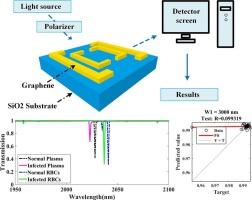下一代等离子体混合石墨烯生物传感器:机器学习辅助开发,用于基孔肯雅病毒的有效检测
IF 5.1
3区 材料科学
Q2 MATERIALS SCIENCE, COATINGS & FILMS
引用次数: 0
摘要
基孔肯雅病毒(CHIV)的早期发现对于有效的疾病管理至关重要,因为全世界已有近60个国家报告了这种感染。艾滋病毒感染通常会导致疲劳、肌肉疼痛、关节肿胀和严重头痛,因此需要可靠和高度敏感的诊断方法。为了提高基孔肯雅病毒感染血浆和红细胞(红细胞)检测的效率和精度,设计并优化了一种新型双方框支架型谐振腔折射率生物传感器(DSBRRIB)。所使用的硅衬底尺寸为8000nm × 8000nm,常规厚度为500nm,波长范围为1950 ~ 2100 nm。所提出的生物传感器利用石墨烯基等离子体结构来提高灵敏度、稳定性和整体性能。针对特定的血液成分增加了诊断的特异性,确保在区分自然和受影响的样本更高的准确性。对不同层数和不同谐振腔结构的石墨烯材料进行了对比分析,以确定最佳探测效率。优化后的生物传感器质量因子值为3196.33 nm/RIU,基孔肯雅热检测的优值为487.64。血浆检测限低至0.000436 RIU,红细胞检测限低至0.000379 RIU。机器学习辅助优化进一步提高了性能,对于支架间隙变化的最佳预测测试精度达到0.099319。本文章由计算机程序翻译,如有差异,请以英文原文为准。

Next-generation plasmonic hybrid graphene biosensor: Machine learning-assisted development for efficient detection of chikungunya virus
Early detection of Chikungunya virus (CHIV) is vital for effective disease management, as the infection has been reported in nearly sixty countries worldwide. CHIV infection typically causes fatigue, muscular pain, joint swelling, and severe headaches, necessitating reliable and highly sensitive diagnostic approaches. This research presents the design and optimization of a novel double square bracket-shaped resonator refractive index biosensor (DSBRRIB) to enhance the efficiency and precision of chikungunya detection in virus-infected blood plasma and red blood cells (RBCs). The silicon substrate used is 8000 nm by 8000 nm in dimension with a conventional thickness of 500 nm, and it measures within the wavelength range of 1950 to 2100 nm. The proposed biosensor leverages graphene-based plasmonic structures to improve sensitivity, stability, and overall performance. Targeting specific blood components adds diagnostic specificity, ensuring higher accuracy in distinguishing natural and affected samples. A comparative analysis of graphene materials with varying layers and resonator configurations was conducted to determine optimal detection efficiency. The optimized biosensor achieved quality factor value of 3196.33 nm/RIU, with corresponding figures of merit value of 487.64 for chikungunya detection. Detection limits were as low as 0.000436 RIU for plasma and 0.000379 RIU for RBCs. Machine learning-assisted optimization further enhanced performance, with the best predictive testing accuracy reaching 0.099319 for bracket gap variations.
求助全文
通过发布文献求助,成功后即可免费获取论文全文。
去求助
来源期刊

Diamond and Related Materials
工程技术-材料科学:综合
CiteScore
6.00
自引率
14.60%
发文量
702
审稿时长
2.1 months
期刊介绍:
DRM is a leading international journal that publishes new fundamental and applied research on all forms of diamond, the integration of diamond with other advanced materials and development of technologies exploiting diamond. The synthesis, characterization and processing of single crystal diamond, polycrystalline films, nanodiamond powders and heterostructures with other advanced materials are encouraged topics for technical and review articles. In addition to diamond, the journal publishes manuscripts on the synthesis, characterization and application of other related materials including diamond-like carbons, carbon nanotubes, graphene, and boron and carbon nitrides. Articles are sought on the chemical functionalization of diamond and related materials as well as their use in electrochemistry, energy storage and conversion, chemical and biological sensing, imaging, thermal management, photonic and quantum applications, electron emission and electronic devices.
The International Conference on Diamond and Carbon Materials has evolved into the largest and most well attended forum in the field of diamond, providing a forum to showcase the latest results in the science and technology of diamond and other carbon materials such as carbon nanotubes, graphene, and diamond-like carbon. Run annually in association with Diamond and Related Materials the conference provides junior and established researchers the opportunity to exchange the latest results ranging from fundamental physical and chemical concepts to applied research focusing on the next generation carbon-based devices.
 求助内容:
求助内容: 应助结果提醒方式:
应助结果提醒方式:


